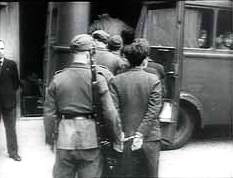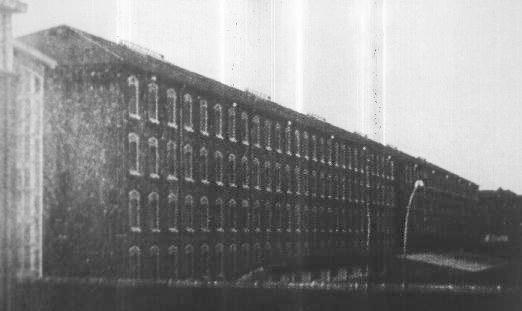Holocaust Education & Archive Research Team |
|
Other Camps
Key Nazi personalities in the Camp System The Labor & Extermination Camps
Auschwitz/Birkenau Jasenovac Klooga Majdanek Plaszow The Labor Camps
Trawniki
Concentration Camps
Transit Camps
|
|||
Flossenbürg Concentration Camp
Statement of A. Mottet
Foreman RAISMES (Nord) France
I was sentenced to death by the War Council of Lille in January 1944 for espionage and membership of the GAULISTE RESISTANCE GROUP FOR LIBERATION. I was taken to the Concentration Camp at Flossenbürg in Bavaria on the 21st February 1944, and put into solitary confinement.
The Camp Commandant was Obersturmbannfuhrer SS Kegler, a native of Allgau, district of Bavaria. His adjutant was Obersturmfuhrer Baumgartner of Kuestrin, he was the real Commandant of the Camp, he alone looked after the prison cells as he was also in charge of preparing the prisoners for the SS Tribunal of Flossenbürg, which was in permanent sitting.
This Tribunal sentenced to death without the accused attending. The executions took place in the prison courtyard by either hanging or shooting in the neck. The victims were first taken to the bath-house – there Scharfuhrer Weihe (a native of Magdeburg) ordered them to take off all their clothes.
He then tied their hands on the back by means of a piece of wire, took off their rings and any religious insignia they had on them, tore up the photos of their families in front of them and finally led them to execution.
Weihe himself did the hangings. The executions by shooting were carried out by Sturmann Weisenborn, Willi (age 43, electrician from Eisenach/ Thuringia, SS volunteer since 1935) and Unterscharfuhrer Wolff, Gerhard (age 46, employee of the gas and electricity works of Wittenberg/ Elbe – Martin Luther’s birthplace – and living there in the Weinstrasse).
In charge of these executions was the Adjutant Baumgartner. If the victims were Russian he often had them whipped before the execution.
Also present were a civilian doctor from a place about 10 kilometres off Flossenbürg, who was attached to the SS, and the SS dentist, who pulled the teeth of the victims after death. The dead were then carried by ordinary prisoners on trolleys to the crematorium, where they were burned, together with people who had died of starvation or disease or maltreatment.
The civilians were not allowed to say a prayer or to give a farewell kiss to their dead comrades. Any suggestions of that kind drew insults and sarcasm. Afterwards the SS shared out any valuables the victims still possessed.
The prisoners who arrived at Flossenbürg from Special Courts or from outside working gangs (mostly Russian and Polish Officers) were held in cells stark naked, without towels, soap, blankets, toilet paper, heating, palliasses, very often 5,6 or 7 in the same cell, without food or water and sometimes they had to wait in this state four days for the execution.
After every execution, Baumgartner distributed cigars, tobacco, and “schnapps” to the SS who had participated. The Scharfuhrer Weihe hanged at least twelve men per day. There were not as many executions by shooting in the neck, but on the 4th September 1944, 132 Russian Officers were shot by Wolff, and two Ukrainian SS who came from the SS barracks for the purpose.
The cell prisoners who had permission for a half hour or one hour’s walk per day were able to observe traces of the executions in the following way:
The clothes of the victims were left in a heap on a trolley in the courtyard, often for several days. In wet weather one could see the prints of nude feet from the prison to the execution place, the blood in the gutter and the particles of brain scattered about.
When executions took place, the daily exercise was belated and shortened and they tried to prevent us from looking around. Also one heard the shots and the screams of the victims.
All cell prisoners were able to see the corpses being carried past their cell windows for about 200 yards. Not only I, but also the following prisoners, have observed all this. They were in single confinement also for a long time and will confirm all this if one saw fit to interrogate them:
Also Messrs Schuschnigg, Ex-Chancellor of Austria and the Prince of Hesse who had a room each. They were not in cells, and being better off than any other prisoners, they could hear better what happened.
On the 9th April 1944, Easter Day, there arrived at Flossenbürg 15 Allied Officers, who had come from the prison of Fresnes (France). They had carried out special missions and had been arrested in civilian clothes in France between June and August 1944.
I was then in Cell 26, my neighbour on the right in cell 25 was a Lieutenant of the British Airborne Infantry, George Desman, whose parents lived in Brussels (he was tattooed a lot on his chest). On my left in Cell 27 there was an American Lieutenant John ….
-I have forgotten his name, he was a Bachelor of Art of the University of Paris, and his father was building autogyros (helicopters) for the US Navy in New York. By means of Morse, we were in touch with each other every day.
They told me that they had been beaten and sentenced to death by the Gestapo in Paris. They and their comrades had been tortured in the cellars of the prison in the Avenue Foch (property of Rothschild) and had received the same treatment which was meted out to me in the same place (blows, kicked, whipped etc.)
Of the 15 there were 13 English, one American and a Canadian Major. The prisoner who brought us our food told us that the Canadian Major and the English Officer, who had occupied cell 23, had been shot on the 12 June 1944, by the Unterscharfuhrer Nies and Mohr, under the command of Baumgartner.
All these officers were in dark cells, had no outdoor exercise, had only the food of the ordinary prisoners, which meant that they were starved to death, they received no treatment in case of illness, left their cells only every 15 days for a shower and a change of shirt. The shower lasted only 5 minutes and they took it singly. They were shaved once a week, and their hair was cut once in two months. Very often they were deprived of food and beaten by Weihe.
During December 1944 and January 1945 – until the arrival of Schuscnigg I was the most senior prisoner and was ordered to help in the distribution of food and the maintenance of the central heating which was situated in the cellar of the prison.
So I often had the opportunity to talk with Captain of Artillery, Harold Bowden, age 37, two children of London. He had been in the French campaign and at Flossenbürg he had Cell 7. He had studied in Paris and in 1942 he had been sent there for the Intelligence Service. He had been beaten by the SS so terribly that his brain was a bit upset.
In Cell number 1 was Lieutenant Jean Worms of Paris, son of the owner of the firm of “La Maison Blanche,” he was in the RAF, Jew, and also on permanent missions to France like Bowden. In Cell number 11 was Lieutenant Phillippe J. Amphlett, of 90 Liberal Club, London, age 27.
I have forgotten the names of the others, but the Englishman Greenwich and the Dane Mogensen, which I mentioned before, can complete this list, because they were also in touch through Morse. Mogensen received often Red Cross parcels and often he gave me books which I succeeded in passing on.
All these comrades of misfortune were hanged on Easter Thursday, 1945, under orders from Baumgartner, just ten days before our evacuation from Flossenbürg to Dachau. On the first Saturday of October 1944, twelve Russian Generals were shot by Wolff in the prison courtyard. One of them wore the badges of a commander of the Armoured Corps.
Three Polish women of the Warsaw Resistance, one of them eight months pregnant, were hanged on the 8th January by Weihe. On the 11th January, two Polish children, 12 and 13 years old were killed and dragged by their legs by Weihe.
Through the cracks in our cell doors we could see the prisoners condemned to death pass by on their way to the executions. Mr Celmin, whom I have mentioned before, can confirm this. Later on one could see the return of the corpses on the trolleys.
My work in the central heating cellar enabled me to see there some instruments of torture, such as whips, oxen-tails, knotted ropes, cat o’nine tails, as well as parts of English, French, Russian and Belgian uniforms.
During one execution I was locked in my cell, but when I went into the cellar afterwards I found bits of jaws and teeth and also bits of brain still sticking to frames which the SS had not burned completely in the incinerator. I often heard screams and groans from the coal cellar which was situated under the prison courtyard, but I was never able to find out more about it.
I would like to mention especially the Prince of Hesse. He was very friendly with the SS Wolff, Weihe and Weissenborg. He was also a great friend of the Commandant, who paid him courtesy calls every week. Before his arrest he had been an SS General.
With reference to the tortures to which I had been subjected in Lille and Paris during the interrogations about my case, I would like to reserve my detailed statement until my return to France. I will just say here that I was not spared anything on behalf of the Gestapo: hunger, oxen-tails, thumb screws, broken teeth, fetters.
I am at the disposal of the Allies for all this information, and after having seen my family again, I am prepared to accompany a mission to Flossenbürg.
I have made this statement as a solemn declaration and I demand that justice be done.
Signed: A. Mottet Foreman Raismes (Nord) France
Naples, 12th May 1945
PS. All guards at Flossenbürg were members of the SS Sturmbann Totenkopf
This is a true translation to the best of my ability.
Signed: F.G.Sutton Captain Bedfordshire & Hertfordshire Regiment
Notes:
The Commandant’s correct name was Max Koegel
The American in Cell 27 was John Sullivan
Sources: NARA T580, Captured German Records Filmed at Berlin (American Historical Association), 1960, rolls 69 and 70. Record Group (RG) 242. NARA Publication Title: Concentration Camp Flossenbürg Inmate Entry Registers, 1938–1945. Holocaust Historical Society. Gedenkstatte Flossenbürg National Archives Kew
Copyright: Chris Webb and Carmelo Lisciotto H.E.A.R.T 2008
|

